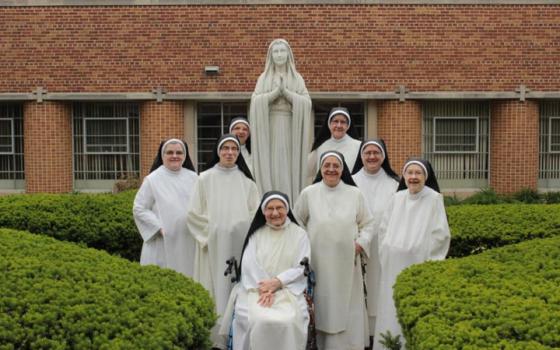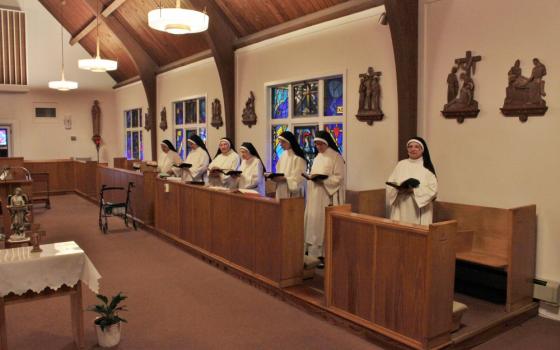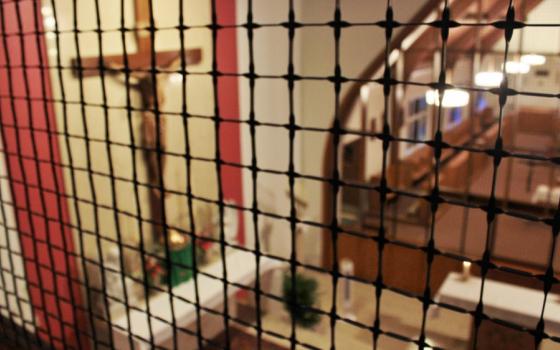On the Lititz Pike just outside of Lancaster, Pennsylvania, traffic thunders in a constant stream, pouring off one of the highways that merge nearby. In a parking lot set back from the road, a red brick building and 1950s-vintage chapel sit side-by-side, unremarkable in an area still notable for religious observance.
Two signs with the word “monastery” on them give the visitor an indication that this is the home of Lancaster’s Cloistered Dominican Nuns of the Perpetual Rosary.
Since 1952, when the monastery was built (though the nuns have been a presence in the Diocese of Harrisburg for 90 years), religious women have resided behind these walls. Their mission is not only a special devotion to the rosary, but a commitment to incorporate the needs of the world into their prayers.
In 1880, Dominican Fr. Damien Marie Santourens, a great promoter of the perpetual rosary among the laity, was inspired to found a new order of the Dominican sisters.
Once there were more than 20 nuns residing in the two-story Lancaster monastery. Now there are nine, ranging in age from 60 to 89. Though some women have sought them out and even discerned a calling to religious life, it has been many years since they received a new postulant.
The “north field” behind the monastery, part of the spacious 6-acre property where the nuns walk on fair days, is no longer a setting for novices playing baseball or volleyball during recreation. The bowling alley on the back porch is long gone.
“Many monasteries have a problem with a big gap in vocations,” said Sr. Mary Albert, the monastery’s sub-prioress. “I don’t think it’s a new phenomenon. It’s a decision that’s more difficult to make in this culture.” Prioress Mary Veronica agreed, describing a secularization of modern life, consumerism, and a wide-spread decline in faith and Christian practice.
Yet the Lancaster nuns still keep a schedule of prayer, study, work and recreation that would have been familiar to their predecessors 50 years ago, rising before daybreak to prepare for morning prayer and Mass and ending their day with night prayer. “Prayer is the key that opens and closes the day,” explained Sr. Mary Veronica.
Though the nuns are separated from other people by a grille in the chapel that adjoins their private worship space, visitors are welcome to participate in public services like the Eucharist celebrated by the chaplain, who lives in a separate section of the monastery.
The stories of what led them to embrace a life of self-sacrifice were different in particulars, but they shared one trait: They came from families steeped in Catholic piety and tradition.
Although they don’t sew as many altar linens as they once did, the nuns here still support themselves by selling handmade rosaries, calligraphy and other religious items in a public area near the front of the monastery. They are also supported by private donations from individuals making prayer requests.
In the past, a doctor would travel to the monastery if one of the nuns were ill, but now they venture out to medical appointments. They also visit a sister who resides in a nursing home. Families are allowed one visit a month (except during Lent, when no visits are allowed).
Grocery shopping is done by volunteers. But the women religious are linked to the outside world through the Internet and a prayer phone line and keep a keen eye on global and local news.
Brought up in a devout family, Sr. Mary Pius first got to know the Lancaster foundation while on a high-school retreat she had attended as a last-minute substitute for someone else. She had wanted to enter religious life since sixth grade, but her mother was still upset that her daughter, who loved dancing, horseback riding and swimming, would be considering a contemplative community.
“She cried terribly when I came to the cloister door,” she recalled, adding that her brother told her that their father also sobbed. In the end, she said, they were both delighted by her choices.
Sr. Faustina Marie already had a sister who had entered religious life when she decided to embrace a calling to an apostolic order. But after 18 years in an active order, working with special-needs children, “I wanted a religious life, not employment.”
While both of her parents recognized the sincerity of her move to a contemplative community, she also reminded them of the cost. “Mom, I won’t be coming home for vacation,” she told her. “Dad, I won’t be watching baseball on the TV with you.”
Sr. Mary Albert was practically engaged to be married when she felt called to religious life, and she eventually broke up with her boyfriend to become a nun.
Sr. Maria Gabriel was a young widow when a mysterious Franciscan brother took one look at her at an Ohio dinner party and said: “Aren’t you supposed to be a nun?”
Perturbed by her encounter with a complete stranger, she still decided to follow up on his suggestion and contacted the Perpetual Rosary Dominicans. Under the (incorrect) impression that the young widow was in Akron, Pennsylvania, the prioress at the time urged her to come spend a time at the monastery. In an attempt to get off the phone, she agreed to meet the nuns.
Sometime later, she entered the Pennsylvania monastery. “The bottom line is, when the Lord plants a seed, he waters it.”
“This life is never boring. Never,” said Sr. Mary Albert.
“It is in dying that we are born to eternal life,” added Sr. Mary Veronica, quoting the words of St. Francis of Assisi.
Nuns don’t claim to be extraordinary mystics (like Sts. Teresa of Avila or John of the Cross), said Sr. Mary Veronica. But they have staked a lot for something that is unseen, yet very real. “What God gives you is a big responsibility,” she said, of the call to the vowed life. “It’s really God’s doing. It doesn’t come from you.”
Asked about what lies ahead for the community, she said that they are in the process of discerning their future path and hoping that recent public attention (a local television station recently featured the nuns in a special segment on the power of prayer) spurs interest. “We have a beautiful monastery. We’re praying and hoping for vocations. If a young woman has the desire to go forward and see if God is calling her here, she is welcome to visit us and see how we live.”
[Elizabeth Eisenstadt Evans is a religion columnist for Lancaster Newspapers, Inc., as well as a freelance writer.]
This is the first profile of a six-part series called Contemplative Communities.
Click here to see the introductory article and other profiles, as well as two related columns.



